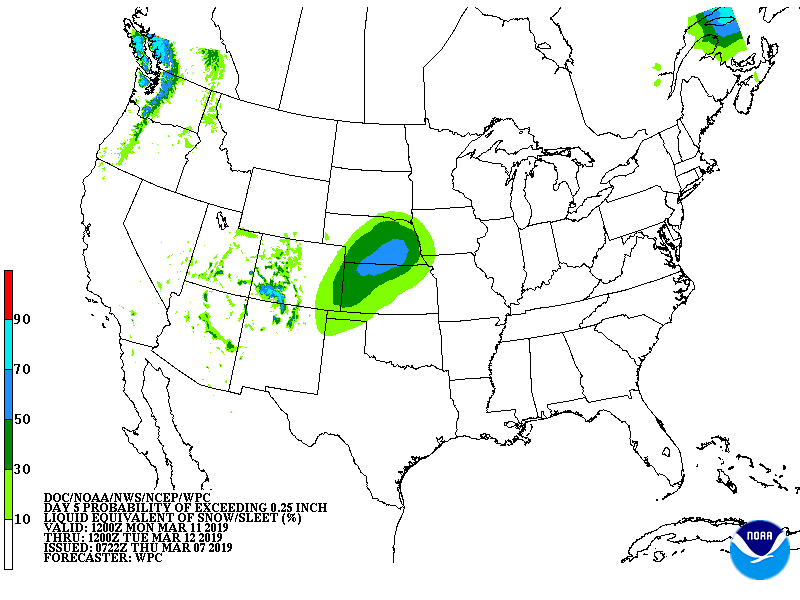| March 12 2019 |
Central U.S. Winter Storm (12-14 March, 2019)
By: Joshua Weiss, WPC Meteorologist
Meteorological Overview:
A significant blizzard occurred from the Central High Plains through the Upper Midwest March 12-14, 2019. The storm originated as a closed 500hPa low west of the Baja Peninsula on March 11, before opening into a wave as it ejected eastward towards the Four Corners by March 12. This open wave then phased with a secondary shortwave impulse digging southward from British Columbia as it lifted towards the Plains. The interaction of the primary wave with this second impulse re-amplified the upper trough, causing it to tilt negatively and close off once again.
As the upper low again closed, enhanced divergence to the east and intensifying 250hPa diffluence due to coupling of a jet streak rotating around the base of the trough with the right-rear quadrant of a secondary jet centered over the Great Lakes, combined to induce rapid strengthening of a surface low in eastern Colorado. During the 24-hour period between the afternoon of March 12 and March 13, bombogenesis occurred as surface pressures dropped 30hPa, bottoming out at 968hPa. During this time, Lamar, CO measured a surface pressure of 970.4hPa, setting an all-time low pressure record for the state. In response to this deepening, the tightening pressure gradient between the surface low and Canadian high pressure diving from Alberta produced strong winds, and as cold air flooded into the Plains, a significant blizzard developed.
As the low rapidly strengthened, an intense 850hPa southerly LLJ of 50+ kts spread tremendous moisture into the Plains as noted by precipitable water anomalies approaching +4 standard deviations above the climatological mean. This moisture would be wrung out by intense mesoscale ascent aiding the already robust synoptic lift. Strongly sloped 925-700 hPa frontogenesis collocated with potent mid-level deformation northwest of the 700hPa low and lift into a maturing trowal produced tremendous snow rates of 1-2”/hr, and several reports of thundersnow were received.
As the surface low began to pull out of Nebraska early March 14, a secondary deformation axis developed close to the low center coincident with enhanced 925-700hPa frontogenesis and subtle left-exit jet streak diffluence. This combined with cold air collapsing into the departing low to dynamically cool the column and change precipitation over to snow across eastern Nebraska. This snow became intense, and gusty north winds during the snowfall produced a short-duration blizzard after temperatures had previously been in the 50s (F).
The surface low became vertically stacked and occluded on March 14. As the 500hPa low opened, the surface low weakened considerably and moved quickly into the Great Lakes. Additional moderate snowfall occurred across eastern North Dakota, Minnesota, and Wisconsin, but by March 15 the low had exited well into Canada and dry advection from the west brought an end to the event.
Impacts:
Widespread snowfall of 1-2 feet occurred from March 12-14, stretching from southern Colorado northeast through the Central and Northern Plains and into Minnesota. The highest amounts exceeded 2 feet in the mountains of Colorado, with 45 inches reported at Wolf Creek Pass. Other significant snowfall amounts included 26 inches just outside of Casper, WY, 18 inches in Kadoka, SD, 17 inches near Chadron, NE, and 13 inches in Ashley, ND. Casper, WY set a daily snowfall record of 13.6 inches, which was also its second snowiest March day on record. Cheyenne, WY measured 14.0 inches which was also a daily record, and the 4th snowiest day ever in the city.
Wind gusts reached as high as 100 mph in New Mexico and Colorado, with widespread gusts of 70-80 mph across much of the Central Plains. Denver set a record for its fastest non-thunderstorm wind gust ever recorded at 80mph. This combination of wind and snow led to numerous locations officially reaching blizzard criteria, as well as incredible blowing and drifting of the snow, with some drifts over 12 feet high reported in South Dakota.
Travel became impossible during the height of the storm. Numerous accidents and car strandings were reported, leading to hundreds of rescues and widespread road closures. This included the major interstates of I-90 in South Dakota, I-80 through Nebraska and Wyoming, I-70 and I-25 in Colorado, and I-94 in North Dakota. At one point on March 14, nearly every roadway in South Dakota and the panhandle of Nebraska was shut down. Air travel was significantly affected, with more than 2000 flights cancelled during the storm, many of these originating out of Denver International Airport which closed all runways for only the 4th time in history. Most flights at the smaller airports from Nebraska through North Dakota were also cancelled. The snow and wind led to hundreds of thousands of power outages as well, and even caused some roof collapses in North Dakota.



